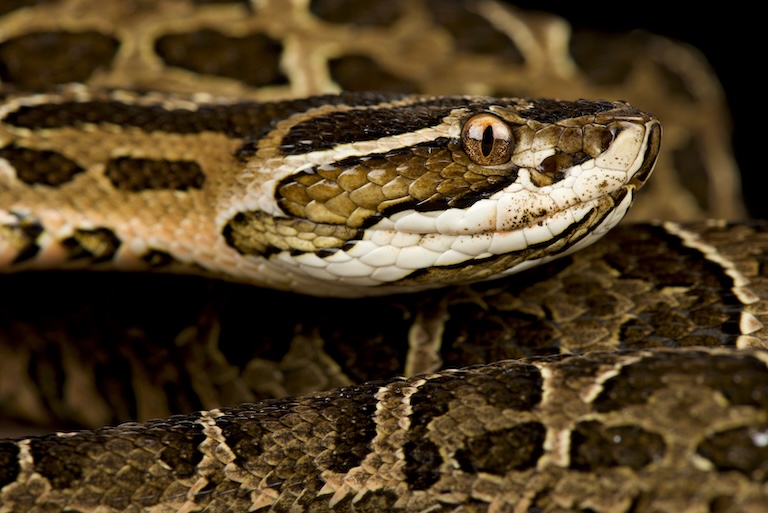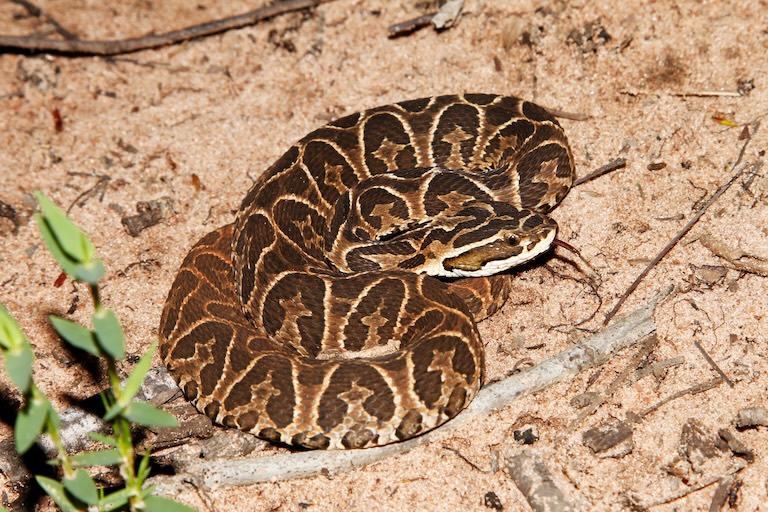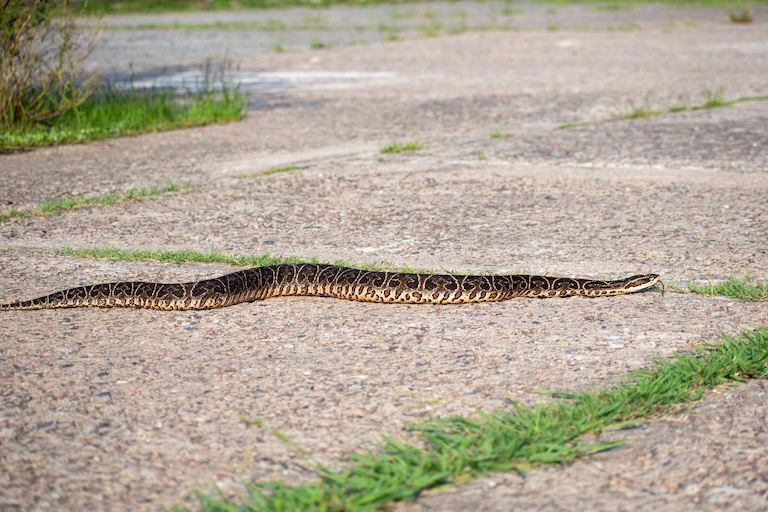Urutu Profile
In Brazil, there’s a well-known jungle monster, well camouflaged, powerful, and able to cross both land and water with ease. Its rugged, yet simple nature has seen it spread to three continents, and there were, at one time, more than 30 armies and security forces making use of these beasts as military assets. This is the Urutu, a Brazilian amphibious armoured personnel carrier, and almost nothing like the American snake of the same name, which can’t even fit half the number of soldiers in it.

Urutu Facts Overview
| Habitat: | Low-lying, swampy areas; forests, sugar cane plantations |
| Location: | South America |
| Lifespan: | Unknown |
| Size: | 169 cm (67 in) confirmed, possibly more than 2 m (6.6 ft) long |
| Weight: | Often more than 3kg (6.6 lb) |
| Colour: | Brown to green or tan with darker patterns |
| Diet: | Small mammals |
| Predators: | Raptors |
| Top Speed: | Sluggish but fast to strike |
| No. of Species: | 1 |
| Conservation Status: | Least Concern |
The Urutu is a member of that “Other” genus of New World pit viper. Not a rattlesnake, but a Bothrops species, with a similar reputation. In Spanish, it’s called “Yarará grande”, meaning “Big rattlesnake”, and at more than a metre and a half long, it’s half right! These pit vipers are striking in more ways than one, and are medically significant, though fatalities are less common than their reputation would suggest.
Urutus are hard to identify on account of their huge variation in colour, but once you get familiar with a few consistent patterns, this becomes simpler.
Interesting Urutu Facts
1. They’re pit vipers
Vipers are immensely successful snakes, distantly related to the colubrids, from whom it’s thought they diverged in the Eocene, and like the colubrids, they have spanned much of the planet.
The places vipers haven’t managed to conquer are either so cold that they’re entirely devoid of snakes in general or islands. Unlike colubrids, they’re not as keen to swim, and so most of their range is connected by landmasses.
The Americas have only a single subfamily of vipers, yet this subfamily contains the most species: more than half of the vipers are pit vipers, or members of the Crotalinae subfamily. They’re found worldwide, too, but they are the only vipers found in the New World.

They’re called pit vipers because of a special sensory organ, essentially an eye, that sits between the eye we’re more familiar with and the nostrils. It’s called the loreal pit, though snakes don’t have hair at all, so rather than being related to the shampoo, this loreal refers to a location on birds and reptiles between the eyes and nostrils.
This “eye” picks up on light emitted below the visible spectrum, in the infrared region. This is the light we can’t see, and what we commonly refer to as “heat”. The signals from this pit are processed by neurons that work with optical information, so pit vipers have heat sensors on their faces that allow them to see mammalian body heat in the dark. Like the Predator. Cool!
Interestingly, this isn’t remotely unique, and most vipers, as well as boas and pythons, have some form of heat sensor for the same reasons. But those in the pit vipers are particularly adept. 1
2. They’re very venomous
This snake is a member of the Bothrops genus, and this genus is the one responsible for the most human deaths of any snake group in the Americas. But there’s more to this tale than meets the heat-sensing eye.
Like a lot of vipers, this one has a nasty bite. But, like almost all snakes everywhere, the danger, while significant, has been exaggerated by the cultures affected by it.
A bite from an Urutu is nothing to sleep on, for sure. And it has killed people. But this is a snake that has a bad reputation in Brazil, as one of, if not the, most deadly snake in the forest. But the stats don’t match the reputation: fatalities are estimated to occur in fewer than 2% of bites. Still, symptoms are not pleasant.
Hemotoxins slow the clotting time of the blood, leading to, well, more blood. This can also start escaping from the gums like Tom Cruise after biting that rat in Interview with the Vampire. Necrosis around the bite wound occurred in 9% of those surveyed, and secondary infections can be nasty, too.
So, this species isn’t one of the most venomous in the genus, and this genus as a whole is primarily dangerous because they lurk in the forest at night, and people step on them. But while perhaps not as dangerous as the Crotalus, or rattlesnake genus, these are certainly dangerous animals.
Another confounding factor is that this species can be difficult to identify on account of its varying a lot in colour. 2

3. They come in various colours
Many species of snake have lots of natural variation in colour between individuals, but typically this variation comes in the pattern colours over the base colour. Not in the Urutu! Even the base colour varies a lot, from brown to grey, sometimes greenish.
The pattern itself is where you need to look to identify this species, though these vary a bit, too. The most obvious markers are the cross-shaped brown or black marks along the back, which can also look a bit like headphones, rather than a cross, and so aren’t all that reliable, either! 3
4. They give birth to live young
Like a lot of Bothrops snakes, the Urutu gives birth to live young. These little killers are pretty substantial at birth, around 30 cm in length already, and there can be anywhere between 3 and 24 or more per litter.
They are almost identical to the mother at birth, only brighter in colour, faster, and quite a bit wetter. Immediately, they are capable of inflicting a venomous bite – they must be, since snakes aren’t all that good at breastfeeding and generally don’t care at all for their babies.
5. They’re unpopular among farmers
The biggest threat to this species appears to come from persecution by the rural communities that share its range. This species is primarily a forest species, but among artificial habitats, it’s most commonly found in sugarcane plantations.
This, as you’d expect, leads to the classic cases of people stepping on snakes, and stimulates a justified fear among those communities. What is perhaps unjustified is the persecution that results from this, when thick rubber boots could do the same thing without removing what is essentially a farmer’s friend for eating the rodents that will otherwise destroy the crops.
Still, this has a minor impact on the species as a whole, and they are considered of least concern by the IUCN. Having said that, the population trend is unknown, and the last assessment was in 2014, so there’s potential for this to change soon. 4
Urutu Fact-File Summary
Scientific Classification
| Kingdom: | Animalia |
| Phylum: | Chordata |
| Class: | Reptilia |
| Order: | Squamata |
| Family: | Viperidae |
| Genus: | Bothrops |
| Species Name: | alternatus |
Fact Sources & References
- Biswas et. al (2025), “In ‘hot’ pursuit: exploring the evolutionary ecology of labial pits in boas and pythons”, The Royal Society.
- Wolfgang Wüster (2005), “The Venomous Reptiles of the Western Hemisphere”, ResearchGate .
- DUMÉRIL et. al (1854), “Bothrops alternatus”, The Reptile Database.
- (2014), “Urutu”, IUCN Red List.
